How Humans Change Podcast Interview — Movies and Corporate Governance
Posted on June 19, 2019 at 7:30 pm
Many thanks to Josh Chambers of How Humans Change for this very thoughtful interview about my two careers.
Posted on June 19, 2019 at 7:30 pm
Many thanks to Josh Chambers of How Humans Change for this very thoughtful interview about my two careers.
Posted on February 28, 2019 at 8:00 am
I always love talking to Jodi Benson, who provided the sweet voice of Ariel in “The Little Mermaid,” now, incredibly, celebrating its 30th anniversary with a special new DVD/Blu-Ray. On The Credits, you can see our interview.
Posted on January 7, 2019 at 8:00 am
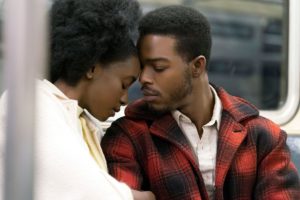
My interview with Ms. Layne was for the Alliance of Women Film Journalists. She spoke about the support her character gets from her strong, devoted family.
The love in that family is just so, so powerful. We see the beauty of having those people to lean into and having those people around that are nurturing you and nurturing your growth. Tish has some growing up to do. Her family encourages that but it’s not all, “You’ve got to get over this.” It wasn’t that type of energy. It’s just like, “Hey, this is a situation that you’re in but really we’re all in it together,” and I think that was the beauty of the family dynamic in this film.
And I spoke to Barry Jenkins for rogerebert.com. He described the one scene where he augmented Baldwin’s story.
Another one of my favorite scenes is the one where they’re in the loft with the young landlord after so many rejections. It is so delicate and charming.
The character was in the book but it’s one of the few places in the translation that I’ll say I felt it didn’t go just far enough for me and so as I was walking around the space I just had this thought in my head like, “How in the hell could you possibly see a way to turn this into a home?” Then I realized, “Oh, but what says love and faith more than a lover saying, ‘I promise I can do this’ and you say ‘Okay, yes I believe you,’” So that’s when we added this whole thing of how we’re going to make this into a home and then him showing where he’s going to put all these things and then I was like, “Oh, it feels kind of cute let’s just go all the way with this pantomiming with the fridge,” and when we did it, there was something so lovely about watching Dave Franco and Stephan James perform this kind of joke in a certain way which was rooted in love and faith that when we got to the roof it also seemed like, “Okay, and now these characters feel connected. How can we take it one step further?”
This idea of mothers in the film is so important. Tish has a mother and she is pregnant, Fonny has a mother, Victoria Rogers, the woman who’s been sexually assaulted, she’s pregnant. She’s not showing but she’s pregnant. It’s all this idea of mothers. I thought, “Oh, here is something that I can see uniting these characters,” and that’s when we gave Dave Franco the line, “I’m just my mother’s son.” Sometimes it’s that idea that makes the difference between us and them; not black and white but people who have been loved and the people who haven’t.
This was adapted with I think much respect and deference to Mr. Baldwin, but that was one of the places where I’m really proud of how I was able to fuse my voice and his.
Posted on November 30, 2018 at 3:34 pm
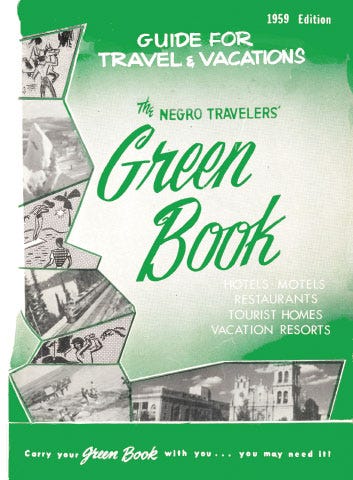
Nat Gertler’s About Comics is the publisher of the reprinted Green Book, the travel guide that inspired the title of one of the year’s best movies. It listed hotels, restaurants, and other businesses that welcomed Black tourists before the 1964 Civil Rights Act required public accommodations to be open to everyone. In the movie, Black musician Don Shirley was restricted to modest-to-shabby Green Book-listed businesses while his white driver stayed with the other members of the trio at whites-only hotels. In an interview, Gertler explained the history of the Green Book and how the reprint became one of his most popular publications.
How did the Green Book get started and who published it originally?
Victor Hugo Green started the annual series in 1936. He was a mailman, delivering the mail in Hackensack, New Jersey but living in Harlem. The first year’s book just covered the New York area, but the demand for a national book was quickly apparent.
How did people buy it? Bookstores or through the mail?
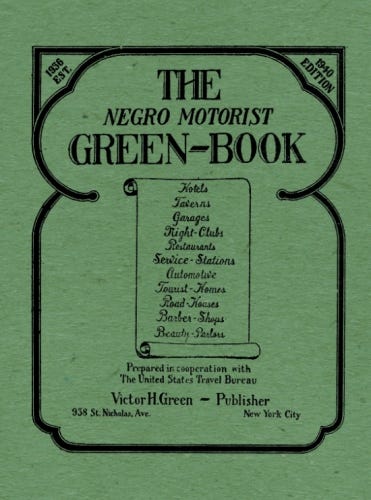 The Green Book was available through the mail, and some Black organizations made it available to their members. And some of the locations listed in the book got copies to distribute — after all, if you were staying at one hotel that accepted Black customers, odds are you were going to do some traveling and need to stay somewhere else. Some years’ editions had cover versions with places for those hotels to stamp their names and addresses. But perhaps the most interesting source was gas stations — specifically Standard Oil stations (that was Esso then, Exxon now.) Unlike other major gas chains, Standard Oil allowed African Americans to own station franchises. In the 1949 Green Book — that’s one of the eight editions that I’ve reprinted so far — there’s even an article by Standard Oil’s special representative to what was then called the “Negro market.”
The Green Book was available through the mail, and some Black organizations made it available to their members. And some of the locations listed in the book got copies to distribute — after all, if you were staying at one hotel that accepted Black customers, odds are you were going to do some traveling and need to stay somewhere else. Some years’ editions had cover versions with places for those hotels to stamp their names and addresses. But perhaps the most interesting source was gas stations — specifically Standard Oil stations (that was Esso then, Exxon now.) Unlike other major gas chains, Standard Oil allowed African Americans to own station franchises. In the 1949 Green Book — that’s one of the eight editions that I’ve reprinted so far — there’s even an article by Standard Oil’s special representative to what was then called the “Negro market.”Who vetted the hotels and restaurants? Were most of them black-owned?
The Guide tries to make clear that the listings aren’t endorsements — a normal listing isn’t mean to guarantee the quality of an establishment, that it just indicates that they were willing to take travelers of color…. although at times they created the implication that businesses that went beyond the simple listing and bought an ad were, of course, particularly good places to stay. Some businesses submitted themselves for listings, some were submitted by customers, but one particularly good source were African American postal workers, just like Green himself. After all, mailmen travel the neighborhood, they know what’s going on.
How does a business with a name like “About Comics” end up publishing something so non-comic as the Green Book?
About Comics is a small company… just one guy, that’s me. If you hear me saying “we,” that’s the corporate “we,” much like the royal “we.” And most of what I’ve published over the years have been comics or at least comics-related, but I’ve got no boss I have to convince when I want to try publishing something else. A lot of what I did is simply driven by my curiosity; when I get to wondering about something, trying to publish it is my way of doing research.
Maybe about three years ago, I read a couple articles about the Negro Motorist Green Book, and it immediately caught my curiosity. It linked to some things that my stepmother had told me. My stepmother, Poco, is half Black, half Cherokee, and when she was in high school she’d be going to one of her athletic competitions, but the bus would leave all of her teammates, all white girls, at one of the hotels in town and then have to drive Poco out to someplace beyond the city limits where she could stay. The sweetest woman you can imagine — I didn’t know her as a teen, of course, for all I know she was a hellion back then, but that’s neither here nor there, that’s not what she was being judged on. Still, to know she was treated like that.
So I was curious about the Green Book, decided to get one for myself so I could experience it… and then found that they were collectors items, museum pieces really. Museums were paying tens of thousands for one. That wasn’t in my budget, at least not just to satisfy my curiosity. But hey, why not see if I could republish it? If there was enough demand for the original editions to send the price that high, maybe I could sell a couple hundred copies of a facsimile edition and make it worth the time I put into reprinting it… and if not, hey, at least I’d have satisfied my own curiosity. And, lucky for me, it turned out that I was not the only one curious about it.
What surprised you about what it included?
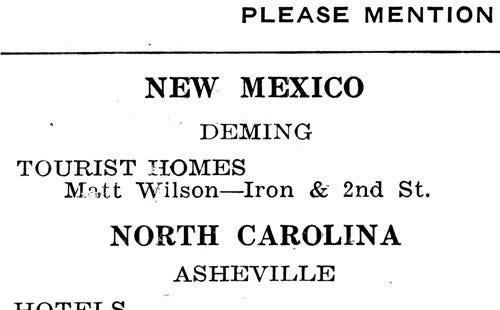
I kind of expected it to be a book filled with anger, with screeds against discrimination and with warnings about the horrible things that might happen to you in certain places… but what I found was a very practical document. Just listings of places that were willing to take you as a customer, and maybe some articles, travelogues or other travel advice. And in a way, that was even scarier, even more horrible, because the practicality of it all just lets you know how damnably rote this all was. Green didn’t need to explain to the reader what the problem was, his readers knew what problem was being addressed. And he didn’t need to warn against going certain places, just let you know where you could go… and the sparseness of locations at time told a story. The first volume I reprinted — the 1940 edition, still my best seller — for the entire state of New Mexico, there’s only one entry, just one place to stay. And it’s listed as a “tourist home”, and what that meant was that this wasn’t a hotel, this was just some Black family that was willing to put you up for the night on your trip, kind of the AirBNB of its day. Now, this might not have been the only actual relevant business in New Mexico, the Green Book was still growing and learning about the places that were out there… but if it wasn’t listed in the Green Book, how were you going to find it?
When did you get started in publishing? What have been your most popular titles?
This year is About Comics’ 20th anniversary. At the moment, the 1940 Negro Motorist Green Book actually is our biggest seller — it sells well through Amazon, and we sell a lot of copies to museum gift shops. In terms of comics material, our best sellers have been our books of the stuff that Charles M. Schulz did besides Peanuts, like the book we have out collecting his other newspaper series, It’s Only a Game, which he did for newspapers in the late 1950s. But we’ve also had really strong sales on things we do aimed at aspiring comics creators. Panel One, a collection of comic book scripts by big comic book names like Neil Gaiman and Kurt Busiek, and even filmmaker Kevin Smith, has been perennially strong. and our Blank Comic Book Panelbook series, which is literally just books filled with empty triangles for kids to draw comics in, has done surprisingly well.
What’s coming next?
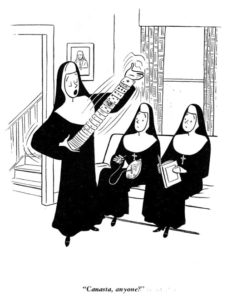
You know how I said that publishing is often my form of research? Well, about a year ago I discovered the odd world of 1950s Catholic cartoon books. These are books mostly of single panel gag cartoons about nuns, and there were dozens of them, some selling in the hundreds of thousands of copies. It’s this subculture that I haven’t really seen anyone try to cover. Anyway, I launched a line on April Fools Day, trying to get everyone to believe that I was only kidding about suddenly publishing a pile of nun cartoon books, when in reality, I was! By the end of the year, I’ll have published two dozen books of these cartoons. The one I’m laying out now is monk and nun cartoons drawn by an actual monk. If folks are interested, I suggest that they follow @dailynun1 on Instagram or Twitter — they’ll get a different nun cartoon in their feed every day, plus they’ll see announcements when I have new volumes out.
And after that? We’ll see what catches my eye.
Posted on October 28, 2018 at 4:27 pm
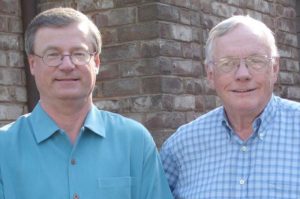
Where were you when you watched the moon landing?
I was on the floor in front of our television set, back in the day when television sets were these console units where the exterior was built into the TV. I was right in front of the TV set on the floor, in Fort Wayne, Indiana between my junior and senior year of high school. I was taking the college aptitude test that summer, working at a golf course mowing grass. I think I watched every minute. I think I was there probably from noon until midnight, so probably 12 straight hours of watching the coverage of Apollo.
So you grew up with the space program.
I was a second grader when Alan Shepherd flew the first space flight. We went down into the gym and took off our shoes and they had a big boxy TV right at the mid-court circle of the basketball court. That flight was just a sub-orbital flight that lasted maybe 15 minutes but I remember very clearly where I was on the floor. There was just something about the age and the era and the promotion of space exploration that grabbed a lot of people. I didn’t do a whole lot between the launches or between the missions but when it did happen I usually found my way to a TV set one way or the other.
One thing that will surprise people when they see the movie is that the space capsule is so small and vulnerable. Is that the way that Neil described it to you?
The vision of the director, Damien Chazelle, was to make the experience immersive for all of the movie viewers and to make it very visceral as well and so I think as a result there’s an emphasis on the sound. If you recall just the shutting of the hatches and everything, it’s almost like they’re being entombed in these things. At one point I went to the museum with Neil where the Gemini VIII spacecraft was still located. The Gemini in particular is just for two men. It’s just such a small space. The Apollo was rather roomy in comparison. I don’t think I did in my book as much as what Damien does in the film to communicate the almost claustrophobic aspects of being in these capsules and so I think the audience will experience this in a way that is in a lot of ways different than it’s been portrayed in earlier movies where you don’t experience the sounds and the vibrations. Damien went out of his way to try to put the viewer in to see it through Neil’s eyes, to feel it in a very direct kind of way, and I think that’s one of the really incredible things about the film.
What made Neil the right guy for that job?
In terms of his general training and experience for astronaut selection, here is a guy that had flown as a test pilot virtually every advanced experimental flying machine that the country was testing between 1956 and the time he became an astronaut in 1962. He was in fact in the second group of astronauts, which was an incredible group with James Lovell and John Young and Frank Borman and Ed White. Neil was the only one who had any experience for flying a rocket-powered airplane, the X-15, which is shown in the very first scene of the film. In terms of him becoming the commander of Apollo 11, one thing I try to do in a lot of my lectures is make clear that there was nothing preordained about him being the one selected. The approach to putting teams together the key was choosing good commanders and he had a feeling deep down that any of the commanders could have done any of the missions.
So Neil always made sure people understood that his opportunity to command Apollo 11 was really a matter of contingent circumstances. He was in the right place in terms of the order of the rotation. Still, he was really an outstanding person to end up doing it — I don’t think there’s any question about that. He had had the major problem with the Gemini VIII flight. There was some second-guessing about it, but in the end everybody felt like he and Dave Scott had handled that emergency extremely well under unbelievable pressure. So I think all of that’s relevant. On one hand it is important to make clear that he was really well trained and a good person to do this particular mission, on the other hand there were other good men as well that probably could have done it as well as he and I think the other commanders could have done the missions.
What is it that makes someone able to stay calm under that kind of pressure?
One thing that the movie can’t show that the book can and does is that in the movie we only see Neil in three flights, in three flying machines; he’s in the X-15, he’s in the Gemini VIII and he’s in Apollo. The guy made hundreds of flights in hundreds of different machines and he’d been flying since he was 16 years old, so he had experienced so many different flying machines and experiences in airplanes and there have been tough challenging moments in a lot of those flights. He flew 78 combat missions over North Korea and had half of his wing clipped off in one of them and he had to eject from the plane.
If you fly that many times, you are going to run into problems and things that are not working quite right. So the one thing that you can’t communicate in the film is that this guy has been in these things hundreds and hundreds of times. They’re engineers and test pilots in the plane so they really know the systems as well so that is an element that sort of explains their confidence in what they’re doing.
He was calm, but we know from the telemetry data that Neil’s heart rate was one of the highest if not the highest heart rates in almost all those flights and I talked to Neil about it. Neil’s own take on it was that if you really see when his heart rate peaked, it was always when he was in anticipation of some high-performance moment that he was going to have to execute. So really his take was that it wasn’t a representation of stress or anxiety about the flaw but just the body and the mind together getting ready for something that was going to have to be done out of the ordinary. He does have other instances of high heart rates too when he was over at Little West Crater during his lunar EVA. He had to get over to Little West Crater and get back to the lunar module pretty quickly because that wasn’t really a scheduled thing for him to do and there wasn’t much time and mission control was kind of nagging him to get back to the lunar module. When he was over at the crater his heart rate was over 180. Again it’s a question of how you interpret that, but I’ve always been a little bit reluctant to describe him as this cold, calm, collected person what nothing unnerves when a man is running such a high heart rate at the same time.
The movie focuses quite a bit on the way that Neil dealt with the death of his daughter. What did he tell you about it?
Typically of Neil, it was hard to get him to talk about it. I probably got him to talk about it more than anybody else ever had. As the movie makes it clear, he didn’t even talk to Janet about it and Janet told me the same thing. He just would not talk about it and Janet needed him to talk about it. She needed a husband that was comforting and supporting and she needed to be able to express her own grief. That’s one of the really sad things in their relationship and I think the movie captures that in some beautiful ways, especially that last scene. I got most of my information about the effect of the death on Neil from Neil’s sister June and from Janet because they observed it first-hand. June, who really loves her brother, was very understanding and she told me stories about in the aftermath of the death, stories that reinforced for her what a special love Neil had for that little girl and how it affected him not only in the immediate aftermath of the death but in her eyes how he never got over it.
The line when he responds to a question in his interview for the astronaut program in the movie comes from my book. I asked, “Did this affect your flying in any way?” and he said, “I think it would be unreasonable to assume that it would have no effect.” That’s just classic Armstrong speak. It’s an answer but it’s not terribly direct.
He didn’t really bring her baby bracelet to the moon and leave it there, did he?
There’s certainly no evidence that he did. The thing is there’s also no complete evidence that he didn’t. We don’t know what he took to the lunar surface because the manifest of the contents of his PPK (the personal property kit) where they took personal items has never been seen. Neil apparently had it. I asked him if I could look at it and he was going to try to find it and never found it and the boys don’t have it and Purdue University archives doesn’t have it so we don’t know where it is and even if we do find the manifest was what he took/the personal items that he took if something was really, really private he wouldn’t have necessarily even listed it.
Another part of this is that the visit over to the Little West Crater was not scheduled. It was not part of the mission plan. He just decided to go over and do that himself and what he did over there we really don’t know for sure because the TV Camera wasn’t on him at that point in time so it was a completely private moment. Sometimes the power of poetry prevails over the uncertainty of fact. I’m okay with it because there’s just enough degree of uncertainty about this that it’s not necessarily counterfactual, we just don’t know for sure.